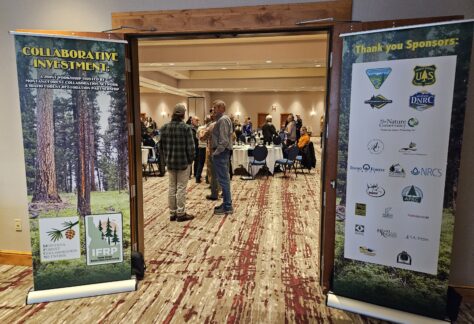
Last week I had the pleasure of attending the Idaho Forest Restoration Partnership (IFRP) + Montana Forest Collaboration Network (MFCN) joint workshop. The creation of the Colorado Forest Collaboratives Network (CFCN) was in part inspired by networks across the West, including IFRP and MFCN, and the coordinators of these Networks have been extremely supportive in the first two years of the CFCN.
I registered hoping to meet new people and gather inspiration for future Colorado Forest Collaboratives Summits. I left feeling a sense of community amongst like-minded folks in other states, energized about continuing to build out the CFCN, and deeply inspired by all the passionate people I met and heard from at the workshop.
A formal Conference Proceedings document from the workshop will be released by the end of the year, and we’ll send that out to the CFCN. In the meantime, below are a few initial takeaways from the workshop.
~Katie McGrath Novak, Coordinator, Colorado Forest Collaboratives Network

1. Idaho Forest Restoration Partnership (IFRP) and Montana Forest Collaboration Network (MFCN) Resources
Although each Network is designed to support collaboratives in its specific state, we have many things in common. I noticed that quite a few of IFRP’s and MFCN’s resources are applicable to Colorado audiences. Here are a few that I recommend for Colorado’s forest collaboratives:
IFRP State of the Forest
Each year, IFRP releases a “State of the Forest” report outlining the latest challenges and innovations across Idaho’s forests. They recently released their 2023 State of the Forest: “Forest restoration priorities: Collaborative process meets national policy”. The article shares a brief history of US Forest Service policy trends and how they have impacted Idaho’s forest collaboratives.
IFRP Recorded Webinars
IFRP occasionally hosts virtual workshops and webinars. Many are available for free here.
MFCN Dashboard/Issue Papers
MFCN has put together a list of short, easy-to-digest dashboard/issue papers with information and quick tips on relevant current issues. Topics range from Creating a Charter for a Collaborative, to an introduction to the Good Neighbor Authority, to Engaging with the Forest Service Before NEPA, just to name a few. You can find the full list of dashboard/issue papers here.
MFCN Quick Reference Guides
MFCN also has a page on their website where they compile a list of existing reference guides on various topics. Check it out here.
2. We all play a part in supporting one another.
On the first day of the workshop, we split into breakout groups to discuss three key questions:
- How might agencies be more effective in fostering collaborative processes?
- How might collaboratives be more effective in fostering collaborative processes?
- How might IFRP & MFCN be more effective in supporting collaboratives?
Below are just a few of the many responses that workshop participants came up with for each question.
How might agencies be more effective in fostering collaborative processes?
- Support formal training in collaborative processes and facilitation at all scales – don’t just rely on individuals’ intuition and values to lead the way.
- Allow and build in time and space for collaboration in peoples’ schedules.
- Have systems in place to more seamlessly transition new people into collaboratives when there is turnover.
How might collaboratives be more effective in fostering collaborative processes?
- Support agencies in gathering social license in communities.
- Embrace conflict! Bring together groups with differing interests.
- Give people options for levels of participation; don’t exclude partners who are not able to give 100%
How might IFRP & MFCN be more effective in supporting collaboratives? (of course, I was listening particularly closely to this one to see what the CFCN can be doing better)
- Provide higher-level advocacy that single groups can’t do as effectively on their own.
- Improve information sharing about other collaboratives – who they are, what they do, contact info – so that collaboratives can build relationships amongst themselves.
- Provide conflict resolution training and facilitation ‘coaching’.
3. You (yes, YOU!) deserve a big pat on the back!
It struck me that each speaker who went on stage (including US Congressmen, the Director of the Bureau of Land Management, US Forest Service regional and forest-level leadership, state foresters, and more) began their segment with a heartfelt THANK YOU to forest collaboratives. The impact of collaboratives’ work is see, heard, and felt nationwide. It can be stressful work, and most people do not get patted on the back nearly as often as they deserve. On behalf of the CFCN and so many others, thank YOU for all you do!

